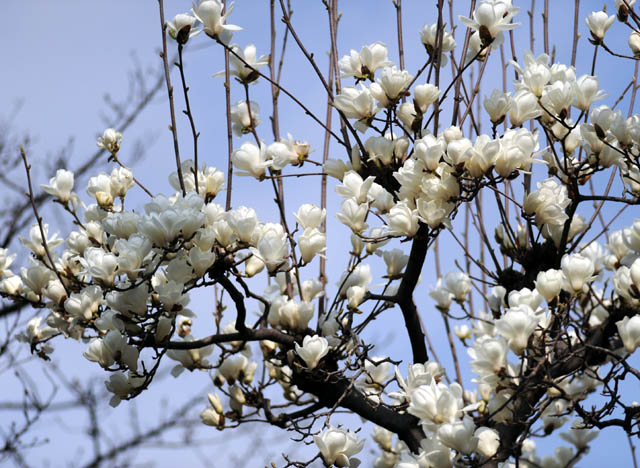A magnolia tree bloomed in the garden of a temple near my house. All the plum blossoms have been scattered, and no cherry tree yet blooms. As for magnolias, white blossoms bloom earlier, and purple ones next. I like white magnolias best among all the flowers.
Saigyo, a poet in the Middle Ages, sang:
I want to die
under the blossoms
in spring
at the night
of the full moon of March.
negawakuwa
hana no shita nite
haru shinamu
kano kisaragi no
mochizuki no koro
He sang about cherry blossoms, but I prefer magnolias for the very last day of my life.

I have an early memory. There was a magnolia tree in the kindergarten where I went. It was late spring and the blossoms had gone. I dug the ground of the kindergarten and found some small stick-like things. I thought they were the stalks of the magnolia blossoms. I took them home and show them to my mother. She turned pale with fear. They were bullets of the machine gun which American fighter planes had shot. The fighters came from the sea. They shot machine guns towards the ground of the kindergarten which was near the shore, and tried whether the guns acted properly. Then they attacked an airport in several kilometers inland. She said, “Once, I was shot by a ‘Grumman’. I saw the pilot looked at me and laughed.”
Many adults have such a memory. American soldiers seem to have shot machine guns in amusement when they found young girls. They might not mean to really hit them, because I have never heard that girls were killed by the U.S. fighter planes. Therefore I think they shot girls for fun. The war makes men crazy.

Many people who survived the war have psychological trauma, but they are reluctant to talk about their experiences to younger generation. They do not talk, I think, because they decided to forgive the enemy. The U.S.A. was not a cruel occupier. Even if they were cruel, the Japanese would forgive them. Generally, the Japanese are not so persistent and vindictive. When my mother talked about the pilot who had shot her, she was not angry at him, but at the war. Still she was not angry at the Japanese government who decided to fight with the U.S.A. She was only angry at the cruel fate called the war. This is the typical Japanese way of thinking.
The Chinese and the Korean are more implacable, and they are still angry at the past act of the Japanese armed forces. However, the barbarity of the Japanese, which they insist on, may not have existed actually. For example, some historians say that so-called Nanjing massacre was made up for the Tokyo Military Tribunal, and did not exist for real. They insist that there is no evidence to prove the slaughter. However, the Chinese government still protests about and claims apology for the holocaust. On the contrary, the Japanese forgave even the A-bombs on Hiroshima and Nagasaki which actually killed 300,000 non-armed citizens.
It is written in Dhammnapada, a Buddhist holy scripture:
For hatred does not cease
by hatred at any time;
hatred ceases by love.
This is an old rule.
na hi verena verâni
sammantîdha kudâcanam
averena ca sammanti
esa dhammo sanantano.

